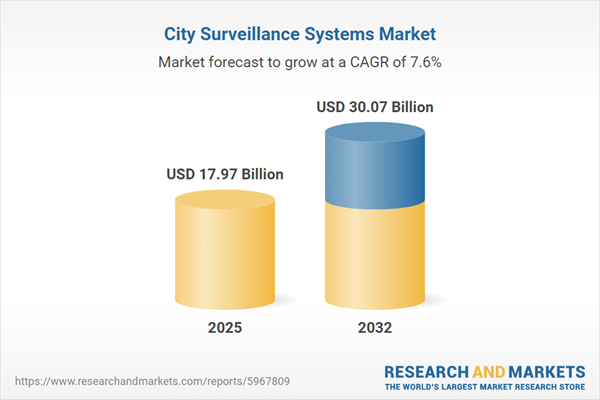Speak directly to the analyst to clarify any post sales queries you may have.
The City Surveillance Systems Market is evolving rapidly as urban areas worldwide prioritize integrated safety, efficiency, and operational resilience. With next-generation solutions spanning advanced camera hardware and intelligent software, decision-makers face new opportunities and complexities.
Market Snapshot: City Surveillance Systems Market
The global market for city surveillance systems is expanding steadily, due to increasing demand for proactive security, real-time situational awareness, and scalable monitoring capabilities. The market grew from USD 16.71 billion in 2024 to USD 17.97 billion in 2025, and is projected to reach USD 30.07 billion by 2032, achieving a CAGR of 7.62%. This trajectory is being propelled by technology integration, rising urbanization, and shifting regulatory demands. Stakeholders are adapting with a focus on end-to-end intelligent surveillance, cloud technology, and partnerships for comprehensive urban intelligence.
Scope & Segmentation
This research delivers a deep dive into the urban surveillance ecosystem, covering all major segments, technology variations, applications, and deployment preferences. The report provides a precise segmentation analysis, allowing leaders to align investment with evolving requirements across key domains:
- Component Types: Camera hardware (including dome, fixed, PTZ, and thermal cameras), network equipment, and storage devices. Service offerings encompassing consulting, installation and maintenance, and training and education. Software solutions such as storage management, video analytics, and video management platforms.
- Technology Variations: Traditional analog infrastructure and modern IP-based architectures, each bringing distinct integration and scalability characteristics.
- Application Areas: Law enforcement, parking management, public safety and security initiatives for public venues, and advanced traffic monitoring such as congestion, incident, and toll management.
- Deployment Models: Flexible options across cloud deployments (hybrid, private, public) and on-premises configurations, suited to governance and performance needs.
- End Users: Commercial enterprises, government agencies (including law enforcement and municipal authorities), healthcare facilities, and transportation companies committed to asset protection and public safety.
- Regions Covered: Americas (United States, Canada, Mexico, Brazil, Argentina, Chile, Colombia, Peru), Europe, Middle East, and Africa (UK, Germany, France, Russia, Italy, Spain, Netherlands, Sweden, Poland, Switzerland, UAE, Saudi Arabia, Qatar, Turkey, Israel, South Africa, Nigeria, Egypt, Kenya), and Asia-Pacific (China, India, Japan, Australia, South Korea, Indonesia, Thailand, Malaysia, Singapore, Taiwan).
- Company Analysis: Includes in-depth trend analysis and developments reported for Hikvision Digital Technology, Zhejiang Dahua Technology, Axis Communications, Hanwha Techwin, Bosch Security Systems, Uniview Technologies, Motorola Solutions, Teledyne FLIR, Avigilon, and VIVOTEK.
Key Takeaways for Senior Decision-Makers
- Integrated urban surveillance is moving toward holistic ecosystems where data intelligence, hardware resilience, and analytics converge to address evolving security challenges.
- Emphasis on interoperability and modular architectures helps organizations avoid high changeover costs and supports long-term scalability with changing standards and technologies.
- The regulatory climate, especially regarding data protection and system governance, is prompting organizations to prioritize encryption, permission hierarchies, and regular risk audits.
- Artificial intelligence and video analytics enable proactive approaches to threat detection, public space management, and resource optimization, enhancing both operational efficiency and responsiveness.
- Regional distinctions drive varying adoption patterns: strict data privacy and innovative analytics in Europe, budget-driven hybrid integrations in emerging markets, and rapid platform upgrades in Asia-Pacific and the Americas.
Tariff Impact: Navigating Hardware & Supply Chain Shifts
The 2025 United States tariff measures on critical surveillance components have introduced new financial and operational complexities for manufacturers and system integrators. Rising hardware and procurement costs have led organizations to reconsider sourcing strategies, driving interest in alternative production partnerships and hybrid cloud models. These policy changes are impacting total cost of ownership, influencing supply chain resilience, and motivating the migration of analytic workloads to more flexible infrastructures.
Methodology & Data Sources
This report’s methodology leverages qualitative interviews with city officials, system integrators, and technology providers, as well as comprehensive quantitative analysis from procurement data, regulatory filings, and industry whitepapers. Cross-referenced secondary sources and scenario analyses ensure robust benchmarking and actionable insights.
Why This Report Matters
- Empowers decision-makers to design surveillance investments that align with both current technology and anticipated regulatory shifts, supporting sustainable urban safety strategies.
- Delivers sector-specific intelligence and strategic guidance for optimizing procurement, partnerships, and system upgrades in a complex, multi-regional environment.
- Supports risk mitigation and cost control through deep market visibility and detailed segmentation analysis.
Conclusion
The City Surveillance Systems Market continues to adapt as cities pursue smarter, safer environments. Leaders equipped with actionable intelligence and segmentation insights can better navigate regulatory, technological, and operational complexities in urban safety.
Additional Product Information:
- Purchase of this report includes 1 year online access with quarterly updates.
- This report can be updated on request. Please contact our Customer Experience team using the Ask a Question widget on our website.
Table of Contents
3. Executive Summary
4. Market Overview
7. Cumulative Impact of Artificial Intelligence 2025
Companies Mentioned
The companies profiled in this City Surveillance Systems market report include:- Hikvision Digital Technology Co., Ltd.
- Zhejiang Dahua Technology Co., Ltd.
- Axis Communications AB
- Hanwha Techwin Co., Ltd.
- Bosch Security Systems GmbH
- Zhejiang Uniview Technologies Co., Ltd.
- Motorola Solutions, Inc.
- Teledyne FLIR LLC
- Avigilon Corporation
- VIVOTEK Inc.
Table Information
| Report Attribute | Details |
|---|---|
| No. of Pages | 192 |
| Published | October 2025 |
| Forecast Period | 2025 - 2032 |
| Estimated Market Value ( USD | $ 17.97 Billion |
| Forecasted Market Value ( USD | $ 30.07 Billion |
| Compound Annual Growth Rate | 7.6% |
| Regions Covered | Global |
| No. of Companies Mentioned | 11 |









